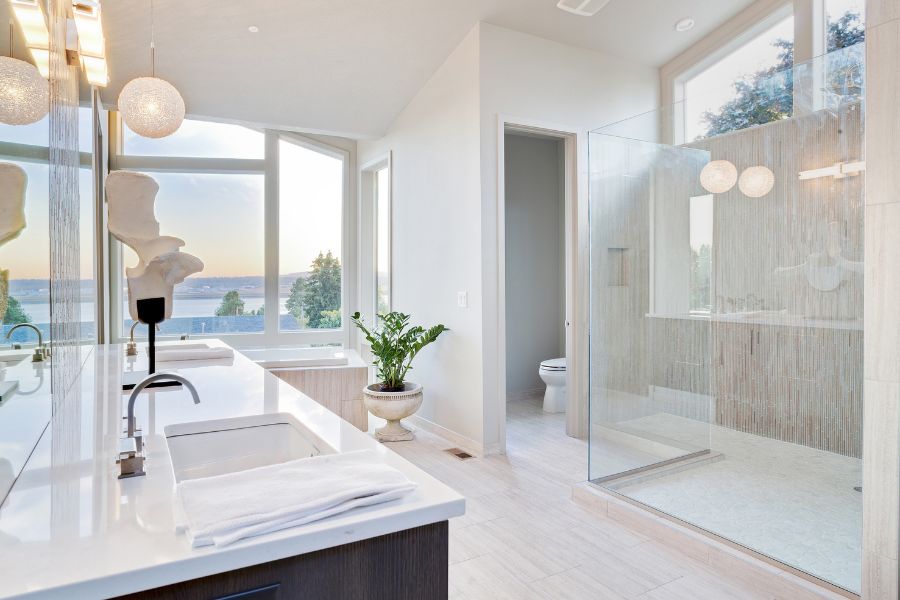Setting the Stage: Key Elements to Consider in Property Staging
Effective property staging involves careful consideration of key elements that can significantly enhance the appeal of investment properties. First and foremost, it is crucial to prioritize decluttering and organizing the space. Potential buyers or renters are more likely to be attracted to a property that appears clean, well-maintained, and spacious. Removing personal items and excess furniture can help create a neutral canvas that allows prospective buyers or renters to envision themselves living in the space.
In addition to decluttering, attention should be given to the overall aesthetic and ambiance of the property. Choosing the right color palette and incorporating tasteful decor can greatly contribute to the overall appeal. Thoughtful placement of furniture and strategic lighting can further enhance the functionality and visual appeal of each room. By creating a welcoming environment that highlights the property’s best features, property staging can significantly increase buyer or renter interest and ultimately lead to quicker sales or rental agreements.
Targeting the Right Audience: How to Tailor Your Staging to Attract Potential Buyers or Renters
When it comes to staging a property for potential buyers or renters, one important element to consider is the target audience. Understanding who your ideal buyers or renters are can help you tailor your staging efforts to attract their attention and make them feel at home. For instance, if you’re targeting young professionals or couples, you might focus on creating a modern and trendy atmosphere with sleek furniture and minimalist decor. On the other hand, if your target audience is families, you may want to emphasize the functionality and durability of your space, showcasing features like a spacious backyard or a dedicated playroom. By customizing your staging to appeal to your target audience, you increase the chances of attracting the right buyers or renters and making a successful sale or lease.
In order to effectively target your staging, it’s important to conduct thorough market research and understand the desires and preferences of your target audience. This includes considering factors such as their age, lifestyle, and purchasing power. For example, if you’re targeting high-end buyers, you may want to focus on showcasing luxurious amenities and high-quality finishes. On the other hand, if your target audience is first-time homebuyers or budget-conscious renters, you might prioritize affordability and practicality in your staging choices. By putting yourself in the shoes of your potential buyers or renters and understanding what matters most to them, you can create a staging that speaks directly to their needs and desires, increasing the likelihood of a successful transaction.
Budget-Friendly Staging Tips: Making the Most of Limited Resources
Staging a property is an essential aspect of attracting potential buyers or renters. However, not everyone has a hefty budget to invest in professional staging services. The good news is that there are plenty of budget-friendly strategies that can help you make the most of limited resources.
Firstly, it’s important to declutter and clean the property thoroughly. A cluttered and dirty space can be off-putting to potential buyers or renters, so take the time to remove any unnecessary items and ensure that every corner of the property is spotless. This simple step can instantly enhance the appeal of the space without costing a dime.
Next, consider rearranging the furniture to maximize space and create a more functional layout. This can make a significant difference in how potential buyers or renters perceive the property. Additionally, adding fresh, neutral paint to the walls can give the space a clean and updated look at a minimal cost. Finally, don’t underestimate the power of natural light. Open up curtains and blinds to let in as much sunlight as possible, as this can create an inviting and spacious atmosphere. By implementing these budget-friendly staging tips, you can make the most of limited resources while still presenting the property in its best light.
DIY vs. Professional Staging: Weighing the Pros and Cons
When it comes to staging a property, one of the key decisions to make is whether to go the DIY route or hire a professional staging company. Each option has its own set of pros and cons to consider.
Opting for a DIY staging approach can be appealing for those looking to save money. It allows property owners to have direct control over the process, from choosing the furniture and decor to arranging the layout. DIY staging can also be a great option for those who enjoy decorating and have a good eye for design. However, it’s important to keep in mind that this approach requires a significant time investment and a certain level of skill to create a polished and marketable look. Additionally, DIY staging may not always yield the same level of expertise and attention to detail as that provided by a professional stager.
On the other hand, hiring a professional staging company can bring a level of expertise and experience to the table. These professionals have a deep understanding of design principles, current trends, and what appeals to potential buyers or renters. They have access to a wide range of furniture and decor options, allowing them to create a cohesive and visually appealing space. Professional stagers can also provide objective advice and make strategic decisions to highlight the property’s best features. However, it’s important to note that professional staging services come at a cost, which may not be feasible for those on a tight budget.
In the end, the decision between DIY and professional staging will depend on factors such as budget, available time, personal skill and interest in design, and the desired level of expertise. It’s beneficial to weigh the pros and cons carefully to make an informed choice that will enhance the appeal of the investment property.
Highlighting the Property’s Potential: Emphasizing Space, Functionality, and Features
When it comes to showcasing an investment property, highlighting its potential is crucial. One effective way to achieve this is by emphasizing space, functionality, and features. Potential buyers or renters are often looking for properties that offer ample space for their needs, whether it’s a cozy living room or a spacious backyard. By arranging furniture and décor strategically, you can help create a sense of openness and highlight the property’s spaciousness.
Another important aspect to focus on is functionality. Buyers or renters want a property that can accommodate their lifestyle and daily activities. Highlighting key features like a well-designed kitchen, a dedicated home office space, or a versatile layout can demonstrate how the property can easily meet their needs. Additionally, showcasing any unique features or upgrades, such as smart home technology or energy-efficient appliances, can add value and attract potential buyers or renters who appreciate these modern conveniences. By emphasizing space, functionality, and features, you can effectively highlight the property’s potential and increase its appeal in the competitive real estate market.
The Art of Depersonalization: Creating a Neutral and Welcoming Environment
Depersonalization is an essential aspect of property staging, as it helps create a neutral and welcoming environment for potential buyers or renters. By removing personal items and belongings, such as family photos and unique decor, the property becomes a blank canvas that allows people to envision themselves living or working in the space. This approach creates a sense of universality and resonance, making it easier for individuals to connect with the property on an emotional level. Taking this step not only enhances the appeal of the property but also increases the chances of attracting a wider range of interested parties.
When depersonalizing a property, it’s important to strike a balance between removing personal touches and still maintaining a warm and inviting atmosphere. This can be achieved by incorporating elements that evoke a sense of comfort and homeliness, such as neutral color schemes, cozy furniture arrangements, and tasteful artwork. The goal is to create an environment that feels welcoming and cozy, while still allowing potential buyers or renters to envision themselves and their own personal style within the space. With the right depersonalization techniques, the property can become a blank slate that offers endless possibilities for its new occupants.
• Removing personal items and belongings helps create a neutral and welcoming environment
• Depersonalization allows potential buyers or renters to envision themselves living or working in the space
• Universality and resonance are created, making it easier for individuals to connect with the property emotionally
• Enhances the appeal of the property and increases chances of attracting interested parties
When depersonalizing a property, striking a balance is crucial.
• Incorporating elements that evoke comfort and homeliness can help maintain a warm atmosphere
• Neutral color schemes, cozy furniture arrangements, and tasteful artwork can contribute to this ambiance
• The goal is to create an environment that feels inviting while still allowing individuals to imagine their own style within the space
Depersonalization techniques turn the property into a blank slate.
• Potential buyers or renters can see endless possibilities for customization
• This flexibility appeals to different tastes and preferences
Creating a Lasting Impression: Enhancing Curb Appeal and the Property’s Exterior
Creating a lasting impression: enhancing curb appeal and the property’s exterior is crucial when it comes to attracting potential buyers or renters. The exterior of a property is the first thing that people see, and it sets the initial impression of the entire property. Therefore, it is important to ensure that the exterior is well-maintained, visually appealing, and reflects the overall aesthetics of the property. This can be achieved through various strategies such as landscaping, painting, and updating the exterior fixtures.
One of the key elements in enhancing curb appeal is landscaping. A well-manicured lawn, trimmed hedges, and colorful flowers can significantly improve the overall appearance of the property. Adding a fresh coat of paint to the exterior walls and doors can also make a dramatic difference. It is important to choose colors that complement the property’s style and architecture. Additionally, updating the exterior fixtures such as the mailbox, door knobs, and house numbers with modern and stylish options can give the property a refreshed look. These small details may seem insignificant but can greatly impact the overall impression of the property.
Staging Strategies for Different Property Types: Apartments, Houses, and Commercial Spaces
Staging strategies play a crucial role in creating an appealing environment for potential buyers or renters across different property types. Whether it is an apartment, house, or commercial space, the goal is to showcase the property’s potential and maximize its attractiveness. Each property type has unique characteristics and requires tailored staging techniques to effectively highlight its key features.
When it comes to apartments, space optimization is key. The use of minimalistic furniture and a neutral color palette can create a sense of openness and allow potential tenants to envision themselves living in the space. Clever storage solutions and smart furniture placement can help maximize the functionality of smaller floor plans. On the other hand, houses offer more room for creative staging. Highlighting the unique architectural elements, such as fireplaces or crown molding, can add a touch of elegance and sophistication. Outdoor areas, such as gardens or patios, can be enhanced with cozy seating arrangements or stylish landscaping to showcase the property’s potential for outdoor enjoyment.
Commercial spaces require a different approach. Staging strategies should align with the intended use of the space. For retail spaces, it is important to create an inviting ambiance that reflects the brand’s identity. Attention should be given to lighting, product displays, and store layout to create a positive shopping experience. Office spaces, on the other hand, should focus on promoting productivity and professionalism. Neutral colors, ergonomic furniture, and well-organized workstations contribute to a welcoming and efficient work environment.
By understanding the unique characteristics of each property type and tailoring the staging strategies accordingly, real estate professionals can effectively showcase the potential of apartments, houses, and commercial spaces to attract the right buyers or renters. The importance of an appealing presentation cannot be overstated, as it can significantly impact the success of a real estate transaction.
Measuring Success: Evaluating the Impact of Property Staging on Profits.
Evaluating the impact of property staging on profits can provide valuable insights into the effectiveness of your efforts. By measuring success in this area, you can determine whether your staging strategies are generating the desired outcomes and contributing to increased profits.
One way to measure success in property staging is by tracking the number of interested buyers or renters that visit the property after it has been staged. By comparing these figures to the number of inquiries or visits before staging, you can determine the impact of your efforts in attracting potential clients. Additionally, monitoring the average time it takes to sell or rent a staged property versus an unstaged one can also indicate the influence of staging on the overall profitability of the investment. These indicators can help you identify which staging strategies are most effective and refine your approach for future opportunities.
Another important aspect to consider when evaluating the impact of property staging on profits is the return on investment (ROI). Calculating the costs associated with staging, such as furniture rental, decor purchases, and professional staging services, and comparing it to the increase in property value or rental income can provide a clear picture of the financial benefits. This analysis enables you to determine whether the expense of staging is justified by the potential profit increase, allowing you to make informed decisions about future staging investments.
By regularly evaluating the impact of property staging on profits, you can fine-tune your strategies, maximize the appeal of your investment properties, and ultimately increase your overall profitability in the real estate market.
What is property staging and why is it important?
Property staging is the process of preparing a property for sale or rent by strategically arranging furniture, decor, and other elements to enhance its appeal. It is important because it helps potential buyers or renters visualize themselves living in the space, increasing the chances of a successful sale or rental.
Are there specific elements to consider when staging a property?
Yes, there are key elements to consider when staging a property, such as furniture placement, lighting, color schemes, and decluttering. These elements play a crucial role in creating an attractive and inviting space.
How can property staging be tailored to attract specific audiences?
To attract specific audiences, property staging can be customized according to their preferences. For example, if targeting families, staging with child-friendly furniture and emphasizing spacious living areas might be beneficial.
What are some budget-friendly staging tips for those with limited resources?
Some budget-friendly staging tips include decluttering and organizing, using neutral paint colors, maximizing natural light, and adding fresh flowers or plants. These simple and inexpensive techniques can significantly improve the overall appeal of a property.
What are the advantages and disadvantages of DIY staging versus professional staging?
DIY staging allows for more flexibility and cost savings, but it requires time, effort, and knowledge of design principles. Professional staging, on the other hand, provides expertise and a polished look, but it can be more expensive. Choosing between the two depends on individual circumstances and resources.
How can property staging highlight the potential of a space?
Property staging can highlight the potential of a space by showcasing its functionality, maximization of available space, and highlighting its unique features. This helps potential buyers or renters envision how they can utilize the space to meet their needs.
What does depersonalization mean in property staging?
Depersonalization in property staging refers to removing personal belongings, photos, and personalized decor to create a neutral and welcoming environment. This allows potential buyers or renters to envision themselves in the space, rather than feeling like they are intruding on someone else’s home.
How can curb appeal and the property’s exterior be enhanced through staging?
Enhancing curb appeal and the property’s exterior can be achieved by ensuring the exterior is well-maintained, adding attractive landscaping, updating the front door or mailbox, and staging outdoor living spaces. These improvements create a positive first impression and entice potential buyers or renters.
Are there specific staging strategies for different property types, such as apartments, houses, and commercial spaces?
Yes, staging strategies may vary depending on the type of property. For apartments, maximizing space and highlighting functionality are key. For houses, emphasizing features like a backyard or unique architectural details can be beneficial. Commercial spaces may require staging that aligns with the intended use and target audience, such as showcasing different room layouts for office spaces or highlighting retail displays for a store.
How can the impact of property staging on profits be evaluated?
The impact of property staging on profits can be evaluated by tracking key metrics such as the time a property spends on the market, the number of offers received, and the final sale or rental price achieved. Comparing these metrics to similar properties that were not staged can provide insights into the effectiveness of staging.


